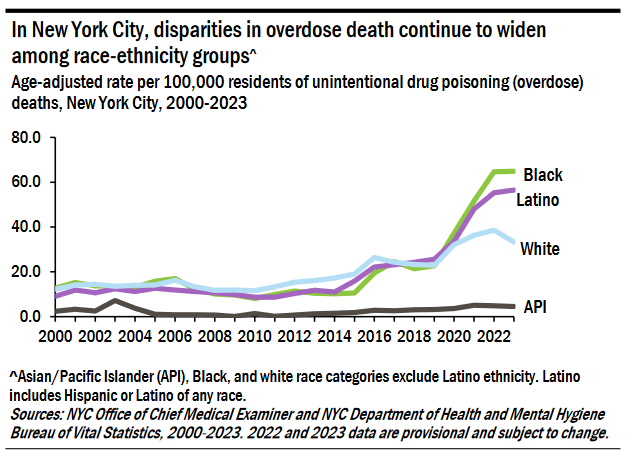



OP-ED: Confronting the racial inequities of the addiction and mental health crises in New York by JONNEL DORIS and SPEAKER ADRIENNE ADAMS November 22, 2024
By JONNEL DORIS & SPEAKER ADRIENNE ADAMS
Over the last decade, more than 30,000 New Yorkers have lost their lives to addiction. While drug overdose deaths in our city have begun to decline for the first time in the past several years, mirroring national trends, the rate of these deaths remains more than twice as high as it was before the pandemic.
Even more troubling is that these deaths have not started to decrease among Black and Latino New Yorkers, indicating the need for far greater attention and more robust public health responses. Deeper investments at the city, state, and federal levels are needed for organizations that provide culturally responsive, trauma-informed care that supports healthy outcomes and recovery for people in these communities. This requires acknowledging the racially disparate responses that have produced these unjust results.
As tens of millions of Americans continue to struggle with unhealthy substance use, Black and Latino communities have been disproportionately impacted by this crisis. Yet, public responses have too often overlooked the racial disparities of this decades-long public health crisis.
While one in three Americans has lost someone to an overdose, Black and Brown communities suffer at much higher rates. Racial disparities in overdose deaths continue to widen in New York City, with 2023 being the fourth year in a row that Black and Latino New Yorkers continued to have the highest rates of fatal overdose, at 64.9 and 56.6 per 100,000 residents, respectively. These are not merely statistical trends — they reflect the tragic loss of our siblings, children, parents, and loved ones.
We understand this is driven by structural injustices and an ongoing failure to address the unique needs of these communities, compounded by decades of racially discriminatory policies and practices.
For too long, communities of color have faced a failed “War on Drugs” rather than public health responses proven to be effective at saving lives. Black Americans are six times more likely to be incarcerated for drug-related offenses, often stigmatized instead of offered treatment. This has created a legacy of criminalization, trauma, poverty, and exclusion, passed down through generations and present in the challenges that disproportionately undermine health in communities.
These disparities are not confined to addiction: communities of color have consistently experienced inequities in health and socioeconomic outcomes.
As the pandemic so clearly showcased, inequitable access to mental and public health resources has left Black and Brown communities with severe health disparities. These only compound the effects of the overdose epidemic.
Black adult New Yorkers are more likely to experience serious psychological distress than their white counterparts. In 2019, the city’s Black and Latino high school students were more likely to report attempting suicide than white students.
Despite this, these communities are less likely to receive treatment, and a lack of funding for mental health services in predominantly Black and Brown neighborhoods limits options for those in need of culturally competent and compassionate care. These alarming disparities in access to care, coupled with harmful criminal legal system responses that exacerbate conditions, contribute to health outcomes in communities that have been historically marginalized.
New York must approach addiction and overdose death disparities as an urgent matter of public health, helping families of color recover and heal and taking responsibility for the inequitable access to public health resources and racially discriminatory criminalization of addiction and drug use.
We must ensure our public dialogue surrounding the overdose epidemic recognizes addiction as a rarely treated health issue with severe racial inequities and use our voices to keep this issue at the forefront of our city’s agenda.
In April 2023, New York City Council introduced its Mental Health Roadmap, a continuously evolving plan to better support New Yorkers in their recovery and treatment, especially in communities that have historically lacked adequate access. To advance these efforts, the Council has worked to expand access to community-based services so New Yorkers can get the support they need in their neighborhoods — the prevention, harm-reduction, and treatment services these organizations provide saves lives.
Community-based organizations like StartCare offer integrated care models tailored to the needs of communities most affected by addiction. At the same time, these organizations require greater investments. They need more funding to sustain and expand their critical work, which not only helps individuals confront addiction but also addresses the broader social determinants of health — such as housing, job stability, and access to care — that are informed by systemic racism.
To meaningfully address this crisis in New York, we need to broaden our support for these community-based models of care that meet people where they are — both physically and emotionally. Creating a more stable infrastructure for behavioral healthcare and promoting equitable access to mental health resources for historically underserved communities is the first step toward addressing the stark disparities that persist today.
The city must prioritize monies and promote policies that will afford organizations that provide comprehensive care to continue expanding and implementing programs that care for the whole person, addressing these disparities head-on.
We can work together to create comprehensive strategies focused on the specific needs of Black and Brown communities. Failing to do so will only result in continued loss of life at disproportionate rates.
Jonnel Doris is the CEO of START Treatment & Recovery Centers. Adrienne Adams is the Speaker of the New York City Council and represents Council District 28 in Southeast Queens.
https://amsterdamnews.com/news/2024/11/22/op-ed-confronting-the-racial-inequities-mental-health/
https://www.nyc.gov/assets/doh/downloads/pdf/epi/databrief142.pdf

Comments3
Very high poverty 93.7; low poverty (wealthiest) 19.9
Very high poverty neighborhoods had a larger increase in overdose death rate
• The overdose death rate among residents of very
high poverty neighborhoods increased by 5%, from
89.4 per 100,000 in 2022 to 93.7 per 100,000 in
2023.
• The overdose death rate among residents of low
poverty (wealthiest) neighborhoods decreased by
9%, from 21.8 per 100,000 in 2022 to 19.9 per
100,000 in 2023
Neighborhoods rates of overdose death and Pb pipes
Neighborhoods with rates of overdose death among residents exceeding the New York City rate, 2023
Rate per 100,000 residents are age-adjusted.
https://www.nyc.gov/assets/doh/downloads/pdf/epi/databrief142.pdf
Do lead pipes deliver water to your NYC building? Check this map.
https://icesaturn.com/Pb-NYC
Why Blacks ORDERS OF MAGNITUDE More NAZI Table 7.
Why Blacks ORDERS OF MAGNITUDE More NAZI Table 7. Number and rate of unintentional drug poisoning (overdose) deaths involving opioid combinations, New York City, 2022-2023
https://www.nyc.gov/assets/doh/downloads/pdf/epi/databrief142.pdf